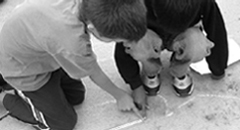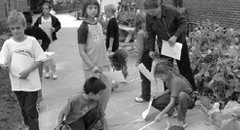
|

|

|
Guiding Principles: Learning and Groups
The following statement is an excerpt from "Four Features of Learning in Groups," by MLV researchers Mara Krechevsky and Ben Mardell in Making Learning Visible: Children as Individual and Group Learners (pp. 285-86):
Our exploration of learning in groups is guided by two principles related to the nature of learning and the nature of groups. First, with regard to learning: Rather than reducing children's or adults' thinking and learning to discrete bits of information that can be produced via simple-answer questions, we are interested in the learning processes and outcomes involved in solving problems or creating products that are considered meaningful in a culture. This is in accord with Howard Gardner's definition of an intelligence as the ability to solve problems or fashion products that are valued in a culture or community. [See H. Gardner, Frames of Mind (New York: Basic Books, 1983/93).] We resist the tendency to simplify the complexity of either the individual's or the group's learning process or the content being learned. The type of learning in which we are interested engages students cognitively, emotionally, and aesthetically. It is situated in real-world problem solving that draws on critical and creative thinking as well as disciplinary knowledge and skills.
Second, by group we refer not only to what individuals learn by virtue of participating in a group, but also to a more distributed kind of learning that extends beyond the learning of any one person. Research suggests that we need to rethink our notions of human cognition as residing inside the heads of individuals and consider a view of knowledge as socially constructed and distributed among individuals, groups, and cultural tools and artifacts (such as books or computers). [See G. Salomon (ed.), Distributed Cognitions: Psychological and Educational Considerations (Cambridge, England: Cambridge University Press, 1993).] We believe that participation in groups is key to the construction of individual learning. We also believe that group learning can lead to creating a community culture or collective knowledge that is greater than what any one individual knows.
We have defined a learning group as a collection of persons who are emotionally, intellectually, and aesthetically engaged in solving problems, creating products, and making meaning--an assemblage in which each person learns autonomously and through the ways of learning of others. Learning groups facilitate a kind of learning that is qualitatively different from that of individuals learning alone. Of course, even in groups individuals learn autonomously, constructing their personal understandings of the world. In this sense, all learning is individual. But when children and adults are in groups, they also learn from and with others. In groups we encounter new perspectives, strategies, and ways of thinking that enable us to learn from others. We also learn with others, modifying, extending, clarifying, and enriching our own ideas and those of others.
Notice that in this sense a learning group may or may not be a collaborative working group, a lab partnership, or a discussion circle--and vice versa. The characteristics identified above are key to our understanding of a learning group.
Learning Groups as Distinct From Cooperative Learning
In the U.S., there have been numerous efforts to develop educational practices that build on children learning together in groups. While there has been considerable interest and activity in this area over the last 25 years, we identify at least four important differences between our work and the "cooperative learning" movement in this country.
- From our perspective, the goal of nurturing the group as a learning environment is not only the achievement of the individual, but the actual capacity of the group to solve problems and make products that no individual, alone, would be able to achieve. Over time, schools and classrooms that nurture group learning can create a community culture or collective knowledge that is more expansive than what any one person knows. In this way, learning groups are like scientific communities or scholarly disciplines that focus on generating collective as well as individual knowledge.
- We include adults as well as children as members of the learning group. We see the role of the teacher in the learning group as one of "collaborator" more than "implementer" or "supervisor." In the U.S., we are all familiar with learning goals for students. Less commonly considered are learning goals for teachers identifying what they would like to learn from classroom experiences. In our view, schools should be places of inquiry for all participants, adults as well as children. Teachers investigate children's points of view and thinking processes so they can enter the children's world on its own terms and facilitate learning more meaningfully.
- At the heart of our conceptualization of group learning is the role of documentation and assessment in making learning visible. Through documentation, children and adults have the opportunity to revisit, both individually and collectively, the work and activities they have planned and carried out. In virtually all American classrooms, even those engaged in group activities and cooperative learning, the assessment paradigm is still one of measurement and evaluation. To be sure, there are very important, though still far too marginalized, contributions to the work of close observation and documentation of student learning. The work of Patricia Carini and the Prospect Center, notably the creation of an archive of student work and the development of the descriptive review processes, are receiving broader exposure. But like most other efforts in this direction in the U.S., Carini's work is overwhelmingly focused on the individual child.
- Finally, many approaches to cooperative learning entail learning basic skills, factual knowledge, and the application of basic algorithms. But we would maintain that children and adults in learning groups should be engaged in the emotional and aesthetic as well as the cognitive dimensions of learning. Teachers look for topics of study that will be intellectually and emotionally stimulating for children and adults. Significant attention is also given to the aesthetic qualities of a project and providing materials or seeking out phenomena that will turn the ordinary into the extraordinary.
Features of Learning in Groups elaborates on these ideas.
[Home] [Site Map]